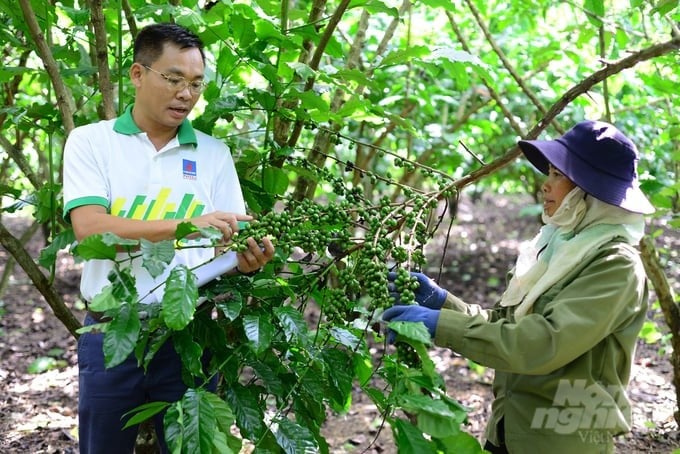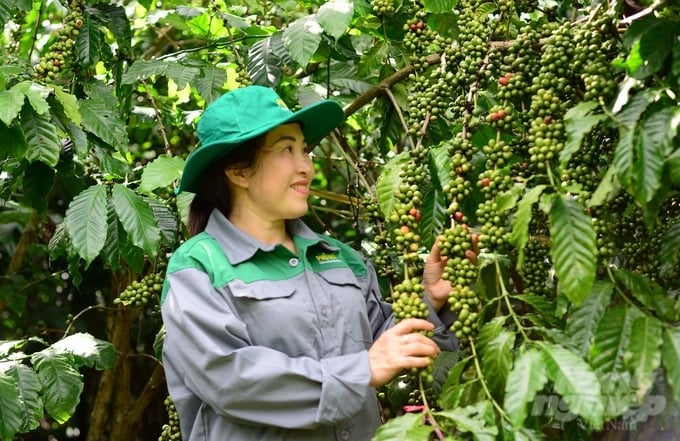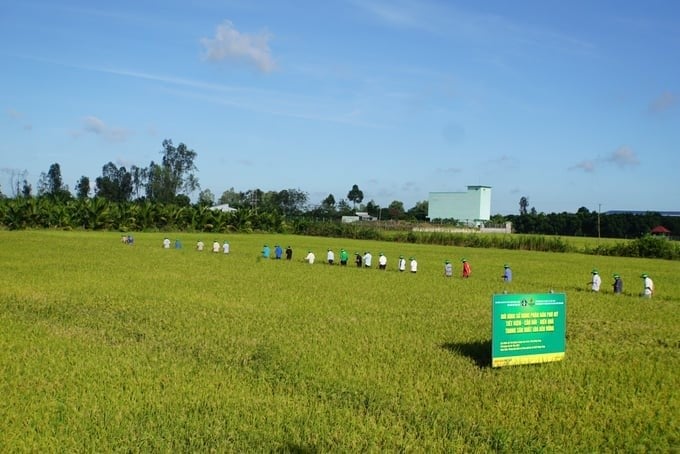May 24, 2025 | 16:19 GMT +7
May 24, 2025 | 16:19 GMT +7
Hotline: 0913.378.918
May 24, 2025 | 16:19 GMT +7
Hotline: 0913.378.918
PetroVietnam Fertilizer and Chemicals Corporation (PVFCCo), a Phu My fertilizer producer and trader, said that this enterprise has coordinated with the Research Center for Highland Soils, Fertilizers & Environment (Soils and Fertilizers Institute) to deploy the model of using Phu My fertilizers on coffee trees at Ms. Do Thi Nga's family (Loc Thang town, Bao Lam district, Lam Dong province).
Here, 0.5 hectares of coffee are used with Phu My nitrogenous, NPK, and potassium fertilizers. According to a representative of PVFCCo, in this model, agricultural experts organize an analysis of pH index, organic matter, indicators of nitrogen and potassium, and a series of other factors to apply a balanced and reasonable fertilization method. Fertilization is also done according to each growth stage and the needs of crops.

According to the assessment, in this year's crop, 0.5 hectares of coffee of Ms. Do Thi Nga's family will yield about 3 tons of beans. Photo: M.H.
According to the assessment, in this year's crop, the entire 0.5 hectares of coffee of Ms. Do Thi Nga's family, which are used with Phu My fertilizers, will yield about 3 tons of beans.
Ms. Do Thi Nga, owner of the model, said that as of now, the family has organized four fertilization sessions and has finished fertilization to prepare for the harvest. "One month after the first fertilization, the plants in the garden had developed many root-hairs. Up to now, all the plants in the garden thrive, have long branches and thick leaves, and are less susceptible to pests and diseases. In particular, the fruit is large, even, and does not drop like before," she said.
According to Ms. Nga, in the past, her family produced according to traditional methods without specific analysis, so the garden easily fell into a situation of lacking or exceeding fertilizer. This has led to a lack of the tree’s uniform growth and low productivity and quality.
“Currently, experts regularly inspect and evaluate so the family can grasp the nutritional needs of plants and apply a balanced fertilization method. This fertilization method also contributes to making the soil loose and retains moisture better," Ms. Nga said, adding that thanks to this fertilization process, the family saves 10-15% of costs compared to traditional methods.
Mr. Luong Duc Tri, an agricultural expert at the Research Center for Highland Soils, Fertilizers & Environment, assessed: "After a period of monitoring, we realized that the application of new technical measures combined with the use of Phu My NPK and potassium fertilizers helped Ms. Nga's coffee garden achieve high efficiency. In addition to yielding 20% higher than the control model, the tree develops reserve branches strongly, so the fruiting rate in the next crop will be very high."
According to Mr. Tri, in this model, the size and weight of coffee fruits increase by 13–19%, and pests and diseases are reduced by 20–25% compared to the control model, helping to significantly limit the costs of using pesticides. Thereby, contribute to protecting the ecological environment and producers’ health. Especially, the quality of garden foundation soil has been significantly improved.

Currently, the coffee garden of Ms. Do Thi Nga's family is thriving, and pests and diseases are reduced by 20–25% compared to the control model. Photo: M.H.
According to Mr. Dang Huu Thang, Deputy Head of PVFCCo’s Research – Development & Market Division, Phu My is a major fertilizer brand in Vietnam. For nearly 20 years, the corporation has always provided quality products to the market. Along with that, the enterprise has also offered sets of technical solutions for farmers to apply in farming to increase productivity, save input costs, and produce safely and effectively. Thereby, minimize bad impacts on the ecological environment and contribute to the development orientation of "green agriculture" and emission reduction.
Regarding the model of using Phu My fertilizers on coffee trees at Ms. Do Thi Nga's family, Mr. Dang Huu Thang said that indicators of growth, tree height, number of fruits, and yield are all higher than the control. This model also ensures savings on fertilizer costs.
Every year, PVFCCo organizes many field seminars to introduce a balanced, reasonable, and effective fertilizer use model to people. In particular, PVFCCo also organizes cooperation between scientists, the government, businesses, and farmers to build models applying scientific and technical advances in fertilizer use to spread to the community.
Since October 2021, the Plant Protection Department (PPD) under the Ministry of Agriculture and Rural Development has held a signing ceremony for a cooperation program on the safe, balanced, and effective use of fertilizers and pesticides in sustainable agricultural production.
Accordingly, PetroVietnam Fertilizer and Chemicals Corporation (PVFCCo), a Phu My fertilizer producer and trader, is one of 15 industry-leading enterprises selected and signed a cooperation agreement by PPD.

A demonstration model of economical, balanced, and effective use of fertilizers in 2022 summer-autumn rice production in Tan Nghia commune (Cao Lanh district, Dong Thap province) was implemented by PVFCCo in collaboration with the Plant Protection Department. Photo: TL.
According to the signing content, PPD and PVFCCo coordinate to disseminate, train, and guide farmers on the safe, balanced, and effective use of fertilizers in agricultural production. They also transfer and disseminate new scientific and technical advances and knowledge to identify and distinguish fake and poor-quality fertilizers on the market.
At the same time, disseminate, train, and guide fertilizer agents and trading establishments on current state documents and regulations in the field of fertilizers; and techniques for safe, balanced, and effective preservation and use of fertilizers so that they can apply and give instructions to farmers when buying fertilizers for use.
In addition, implement demonstration models of safe, balanced, and effective use of fertilizers on some key crops in the locality to promote production and transfer technical farming processes to farmers. Thereby, creating a sustainable value chain in agricultural production towards a safe and sustainable agriculture and contributing to increasing income and improving the lives of farmers.
Mr. Luong Duc Tri, an agricultural expert at the Research Center for Highland Soils, Fertilizers & Environment, said that applying balanced and timely fertilization techniques will help reduce many risks. If fertilizer is applied at the wrong time and does not meet the tree’s needs, it will lead to fruit drop, affecting productivity. According to Mr. Tri, currently, red basaltic soil, especially in perennial coffee gardens in the Central Highlands, is often degraded. Therefore, measures are extremely needed to recover "health" for the soil.
Translated by Huyen Vu Thu

(VAN) The People's Committee of Tra Vinh province has approved an adjustment to the investment policy for the Green Hydrogen Plant project, increasing its area to approximately 52.76 hectares.
![Reducing emissions from rice fields: [2] Farmers’ commitment to the soil](https://t.ex-cdn.com/nongnghiepmoitruong.vn/608w/files/news/2025/05/05/dsc08881jpg-nongnghiep-140632.jpg)
(VAN) Clean rice cultivation model in Thuong Tan commune, Bac Tan Uyen district, is assisting local residents in achieving sustainable agriculture by substantially reducing costs, increasing productivity, and protecting the environment.

(VAN) At the conference to disseminate Resolution No. 68, AgriS introduced its digital agricultural ecosystem and reaffirmed its commitment to accompanying the Government in promoting private sector development and sustainable agriculture.

(VAN) 'Blue Ocean - Blue Foods' initiative is designed to restore marine ecosystems and establish sustainable livelihoods for local communities by cultivating a minimum of 1,000 hectares of cottonii seaweed in the first three years.
/2025/05/21/4642-3-112707_603.jpg)
(VAN) The V-SCOPE project has made direct contributions to three out of six pillars of the Comprehensive Strategic Partnership between Vietnam and Australia.

(VAN) Facing the threat of rabies spreading to the community, Gia Lai province urgently carries out measures to vaccinate dogs and cats on a large scale.

(VAN) Disease-free livestock farming not only protects livestock herds but also stabilizes production and livelihoods for many farmers in Tuyen Quang.